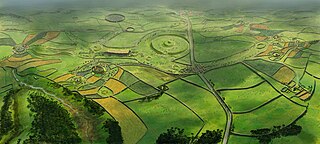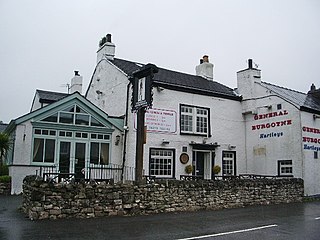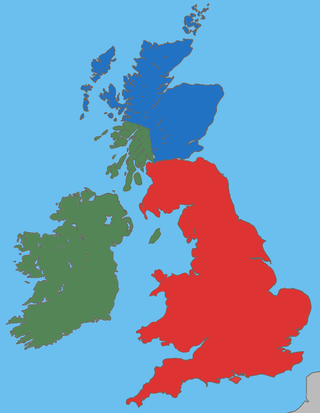Related Research Articles

A crannog is typically a partially or entirely artificial island, usually built in lakes and estuarine waters of Scotland, Wales, and Ireland. Unlike the prehistoric pile dwellings around the Alps, which were built on the shores and not inundated until later, crannogs were built in the water, thus forming artificial islands.

A hillfort is a type of fortified refuge or defended settlement located to exploit a rise in elevation for defensive advantage. They are typical of the late European Bronze Age and Iron Age. Some were used in the post-Roman period. The fortification usually follows the contours of a hill and consists of one or more lines of earthworks or stone ramparts, with stockades or defensive walls, and external ditches. If enemies were approaching, the civilians would spot them from a distance.

Rathcroghan is a complex of archaeological sites near Tulsk in County Roscommon, Ireland. It is identified as the site of Cruachan, the traditional capital of the Connachta, the prehistoric and early historic rulers of the western territory. The Rathcroghan Complex is a unique archaeological landscape with many references found in early Irish medieval manuscripts.

Ringforts or ring forts are small circular fortified settlements built during the Bronze Age, Iron Age and early Middle Ages up to about the year 1000 AD. They are found in Northern Europe, especially in Ireland. There are also many in South Wales and in Cornwall, where they are called rounds. Ringforts come in many sizes and may be made of stone or earth. Earthen ringforts would have been marked by a circular rampart, often with a stakewall. Both stone and earthen ringforts would generally have had at least one building inside.

The Council for British Archaeology (CBA) is an educational charity established in 1944 in the UK. It works to involve people in archaeology and to promote the appreciation and care of the historic environment for the benefit of present and future generations. It achieves this by promoting research, conservation and education, and by widening access to archaeology through effective communication and participation.

Tulsk is a village in County Roscommon, Ireland, on the N5 national primary road between Strokestown and Bellanagare. It sits at around 19 km north of Roscommon town.

Teppe Hasanlu or Hasanlu Tepe is an archeological site of an ancient city located in northwest Iran, a short distance south of Lake Urmia. The nature of its destruction at the end of the 9th century BC essentially froze one layer of the city in time, providing researchers with extremely well preserved buildings, artifacts, and skeletal remains from the victims and enemy combatants of the attack. The site was likely associated with the Mannaeans.

Urswick is a civil parish that includes the villages of Great Urswick and Little Urswick. It is located in the Furness area of Cumbria, England. The villages are situated to the south-west of the town of Ulverston. In the 2001 census the parish had a population of 351, decreasing at the 2011 census to 1,397.
Oxford Archaeology is one of the largest and longest-established independent archaeology and heritage practices in Europe, operating from three permanent offices in Oxford, Lancaster and Cambridge, and working across the UK. OA is a Registered Organisation with the Chartered Institute for Archaeologists (CIfA), and carries out commercial archaeological fieldwork in advance of development, as well as a range of other heritage related services. Oxford Archaeology primarily operates in the UK, but has also carried out contracts around the world, including Sudan, Qatar, Central Asia, China and the Caribbean. Numbers of employees vary owing to the project-based nature of the work, but in 2023 OA employed over 350 people.

Dún Aonghasa is the best-known of several prehistoric hill forts on the Aran Islands of County Galway, Ireland. It lies on Inis Mór, at the edge of a 100-metre-high (330 ft) cliff.
Headland Archaeology Ltd is a wholly owned subsidiary of the RSK Group. Headland provides archaeological services and heritage advice to the construction industry.

The Insular Celts were speakers of the Insular Celtic languages in the British Isles and Brittany. The term is mostly used for the Celtic peoples of the isles up until the early Middle Ages, covering the British–Irish Iron Age, Roman Britain and Sub-Roman Britain. They included the Celtic Britons, the Picts, and the Gaels.
Hillforts in Britain refers to the various hillforts within the island of Great Britain. Although the earliest such constructs fitting this description come from the Neolithic British Isles, with a few also dating to later Bronze Age Britain, British hillforts were primarily constructed during the British Iron Age. Some of these were apparently abandoned in the southern areas that were a part of Roman Britain, although at the same time, those areas of northern Britain that remained free from Roman occupation saw an increase in their construction. Some hillforts were reused in the Early Middle Ages, and in some rarer cases, into the Later Medieval period as well. By the early modern period, these had essentially all been abandoned, with many being excavated by archaeologists in the nineteenth century onward.
Meare Lake Village is the site of an Iron Age settlement on the Somerset Levels at Meare, Somerset, England. It is a Scheduled Ancient Monument.

The tomb of Saint Nicholas is a slab effigy in low relief of an early 4th-century ecclesiastic popularly associated with Saint Nicholas of Myra in County Kilkenny, Ireland. While more probably a local priest from Jerpoint Abbey, it lies in the medieval lost town of Newtown Jerpoint, just west of the Cistercian Jerpoint Abbey.
Archaeology South-East (ASE) is a large contracts division in southern England which provides professional archaeological services for public and private sector clients. Clients include commercial developers and environment agencies and private house owners who require historic building recording services. ASE is based in offices in Portslade, near Brighton with additional offices in London and Braintree and specialises in work in Southeast England including Greater London.

There are over 670 scheduled monuments in the ceremonial county of Somerset in South West England. The county consists of a non-metropolitan county, administered by Somerset County Council, which is divided into five districts, and two unitary authorities. The districts of Somerset are West Somerset, South Somerset, Taunton Deane, Mendip and Sedgemoor. The two administratively independent unitary authorities, which were established on 1 April 1996 following the breakup of the county of Avon, are North Somerset and Bath and North East Somerset. These unitary authorities include areas that were once part of Somerset before the creation of Avon in 1974.

The Silchester Ogham stone is a pillar stone discovered at the Roman town on Calleva Atrebatum in Silchester, Hampshire during excavations in 1893. Thus far it remains the only one of its kind found in England, and the only ogham inscription in England east of Cornwall and Devon. The stone is held in a storage facility of Reading Museum in Reading, Berkshire.

DigVentures is a social enterprise organising crowdfunded archaeological excavation experiences. It is registered with the Chartered Institute for Archaeologists (CIfA), and is a CIfA Accredited Field School.

The archaeology of Wales is the study of human occupation within the country of Wales which has been occupied by modern humans since 225,000 BCE, with continuous occupation from 9,000 BCE. Analysis of the sites, artefacts and other archaeological data within Wales details its complex social landscape and evolution from Prehistoric times to the Industrial period. This study is undertaken by academic institutions, consultancies, charities as well as government organisations.
References
- ↑ "Use of geophysics leads to the discovery of enclosure at Tara". The Irish Times. Retrieved 30 November 2017.
- ↑ Carew, Mairéad (23 August 2016). Tara: The Guidebook. The Discovery Programme: Centre for Archaeology and Innovation. ISBN 978-0-9536973-2-8.
- ↑ Claire, Cotter. Dún Aonghasa : the guidebook. Discovery Programme. Dublin, Ireland. ISBN 9780953697311. OCLC 883511061.
- ↑ "Ogham in 3D". The Discovery Programme. Retrieved 30 November 2017.
- ↑ "Irish Ogham Stones are now available online in 3d". Cultural Heritage Ireland. Retrieved 30 November 2017.
- ↑ "Ogham in 3D News". Ogham in 3D. Retrieved 30 November 2017.
- ↑ McCarthy, Ian. "Archaeology 2025". discoveryprogramme.ie. Retrieved 30 November 2017.